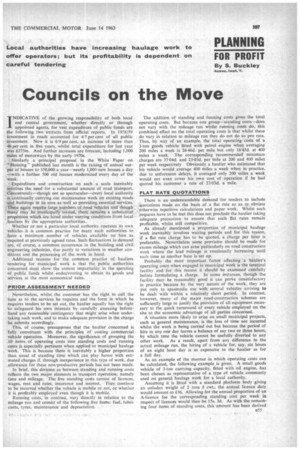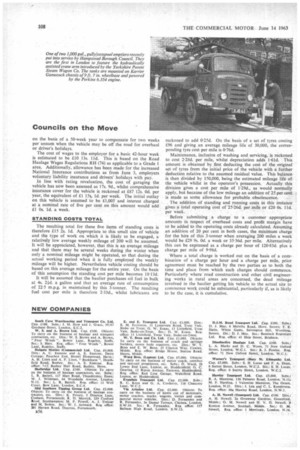Councils on the Move
Page 109

Page 110

If you've noticed an error in this article please click here to report it so we can fix it.
INDICATIVE of the growing responsibility of both local and central government, whether directly or through appointed agents, for vast expenditure of public 'funds are the following two extracts. from official reports. In 1958/59 investment in roads accounted for 4.7 per cent of all public investment. Now it is 6-9 per cent, an increase of more than 46 per cent in five years, whilst total expenditure for last year Was £27.5m. And further increases are forecast, including 1,000 miles of motorways by the early 1970s.
Similarly a principal proposal in the White Paper on "Housing" published last month is the raising of annual output of houses to 350,000 a year—nearly 1,000 new houses a day —with a further 500 old houses modernized every day of the week. .
Expenditure and construction on such a scale inevitablyinvolves the need for a substantial amount of road transport. Concurrently—though not so spectacular—every local authority is continually carrying out maintenance work on existing roads and buildings in its area as well as providing 'essential services. These aeaiti require large numbers of road vehicles and though many may be municipally owned, there remains a substantial proportion which are hired under varying conditions from local hauliers by the appropriate authorities.
Whether or not a particular local authority operates its own vehicles it is common practice for many such authorities to have a minimum number of vehicles available on hire as required at previously agreed rates. Such fluctuations in demand are, of course, a common occurrence in the building and civil engineering industries. due partly to variations in weather conditions and the processing of the work in hand.
Additional reasons for the common practice of hauliers tendering for municipal work is that the public authorities concerned must show the utmost impartiality in the spending of public funds whilst endeavouring to obtain its goods and services at the most economical rates.
PRIOR ASSESSMENT NEEDED Nevertheless, whilst the customer has the right to call the tune as to the services he requires and the form in which he requires tenders to be set out, the haulier equally has the right to safeguard his own interests by carefully assessing beforehand any reasonable contingency that might arise when undertaking such work, and to make adequate provision in the charge he submits accordingly.
This, of course, presupposes that the haulier concerned is fully conversant with the principles of costing commercial vehicle operation. Moreover, the significance of grouping the 10 items of operating costs into standing costs and running costs is especially pertinent when applied to municipal haulage work. This is because there is inevitably a higher proportion than usual of standing time which can play havoc with estimated charges if, through inexperience in this type of work, due allowance for these non-productive periods has not been made.
In brief, this division as between standing and running costs reflects the two major elements in transport operation; namely time and mileage. The five standing costs consist of licences, wages, rent and rates, insurance and interest. They continue to be incurred whether the vehicle is mobile or not, or whether it is profitably employed even though it is mobile.
Running costs, in contrast, vary directly in relation to the mileage run and consist of the following five items: fuel, lubricants, tyres, maintenance and depreciation. The addition of standing and running costs gives the total operating costs. But because one group—standing costs—does not vary with the mileage run whilst running costs do, this combined effect on the total operating costs is that whilst these do vary in relation to mileage run they do not do so pro rata. Thus, by way of an example, the total operating Costs of a 3-ton goods vehicle fitted with petrol engine when averaging 200 miles a week is 26.46d. per mile but only 16-45d. at 400 miles a week. The corresponding recommended minimum charges are 37.04d. and 23-03d. per mile at 200 and 400 miles per week respectively Obviously a haulier who estimated that his vehicle would average 400 miles a week when in practice, due to unforeseen delays, it averaged only 200 miles a week would not even cover his own cost of operation if he had quoted his customer a rate of 23-03d. a mile.
FLAT RATE QUOTATIONS
There is an understandable demand for tenders to include quotations made on the basis of a flat rate so. as to obviate %otherwise repetitive calculations and paper work. Whilst such requests have to be met this does not preclude the haulier taking adequate precaution to ensure that such flat rates remain profitable, whilst still competitive.
As already mentioned a proportion of municipal haulage work inevitably involves waiting periods and for this reason, if a flat rate charge has to be quoted, a charge per hour is preferable. Nevertheless some provision should be made for excess mileage which can arise particularly on road construction work where the lead mileage is continually increasing until such time as another base is set up.
Probably the most important factor affecting 'a haulier's operating costs when engaged in municipal work is the terminal facility and for this reason it should be examined carefully before formulating a charge. In some instances, though the facility may be reasonably good it can prove unsatisfactory in practice because by the very nature of the work, they are put only to spasmodic use with several vehicles arriving to be dealt with within a relatively short period. In contrast, however, many of the major road-constrnetion schemes are sufficiently large to justify the provision of all equipment necessary to the quick turnround of every vehicle employed on the site to the economic advantage of all parties concerned.
A situation more likely to arise on small municipal projects, such as general maintenance, is the loss of time not incurred whilst the work is being carried out but because the period of hire in any one day leaves a balance of say two or three hours, by which time the vehicle cannot be usefully diverted to any other work. As a result, apart from any difference in the actual mileage run, the hiring of a vehicle for, say, six hours of an eight hour day is as expensive to the haulier as for a full day.
As an example of the manner in which operating costs can be calculated, the following example is given. A small goods vehicle of 3-ton carrying capacity, fitted with oil engine, has been chosen as representative of a type of vehicle commonly used on general haulage work for a local authority. Assuming it is fitted with a standard platform body giving an unladen weight of 2 tons 8 cwt., the annual licence duty. would amount to £36. Allowing for the annual proportion of an A-licence fee the corresponding standing cost per week in respect of licences would then be 15s. 3d. As with the remaining four items of standing costs, this amount has been derived
on the basis of a 50-week year to compensate for two weeks per annum when the vehicle may be off the road for overhaul or driver's holidays.
The cost of wages to the employer for a basic 42-hour week is estimated to be £10 13s, lid. This is based on the Road Haulage Wages Regulations RH (74) as applicable to a Grade 1 area. Additionally, allowance has been made for the increased National Insurance contributions as from June 3, employers voluntary liability insurance and drivers' holidays with pay.
In line with rating revaluation, the cost of garaging the vehicle has now been assessed as 17s. 9d., whilst comprehensive insurance covet-1°r the vehicle is reckoned at £87 12s. Od. per year, the equivalent of £1 151, Id. per week. The initial outlay on this vehicle is assumed to be £1,005 and interest charged at a nominal rate of five per cent on this amount would add £1 Os. Id. a week.
STANDING COSTS TOTAL
The resulting total for these five items of standing costs is therefore £15 2s. Id. Appropriate to this small size of vehicle and the type of work on which it is likely to be engaged, a relatively low average weekly mileage of 20owill be assumed. It will be appreciated, however, that this is an average mileage and that there may be several weeks during the winter when only a nominal mileage might be operated, so that during the actual working period when it is fully employed the weekly mileage will be higher. Nevertheless vehicle costing should be based on this average mileage for the entire year. On the basis of this assumption the standing cost per mile becomes 18.13d.
It will be assumed that the haulier purchases oil fuel in bulk at 4s. 2J-d. a gallon and that an average rate of consumption of 22.5 m.p.g. in maintained by this 3-tonner. The resulting fuel cost per mile is therefore 2-33d., whilst lubricants are
reckoned to add 0-25d. On the basis of a set of tyres costing £96 and giving an average mileage life of 30,000, the corresponding tyre cost per mile is 0.76d.
Maintenance, inclusive of washing and servicing, is reckoned to cost 2.28d. per mile, whilst depreciation adds 1-61d. This amount is obtained by first deducting the cost of the original' set of tyres from the initial price of the vehicle with a further deduction relative to the assumed residual value. This balance• is then divided by 150,000, being the estimated mileage life of. the vehicle whilst in the operator's possession. Actually this division gives a cost per mile of 1.29d., as would normally apply, but because of the low mileage an addition of 25 per cent. is made as some allowance for probable obsolescence.
. The addition of standing and running costs in this instance' gives a total operating cost of 25.26d. per mite or £20 Os. lid. per week.
Before submitting a charge to a customer appropriate amounts in respect of overhead costs and profit margin have to be added to the operating costs already calculated. ASsuming an addition of 20 per cent in both cases, the minimum charge for the hire of this 3-tonner when averaging 200 miles a week would be £29 9s. Od. a week or 35.36d. per mile. Alternatively this can be expressed as a charge per hour of 120-83d. plus a charge per mile of 9.98d.
Where a total charge is worked out on the basis of a combination of a charge per hour and a charge per mile, prior agreement must be reached by the two parties as to both the time and place from which such charges should commence. Particularly where. road construction and other civil engineering works in rural areas are concerned, the dead mileage involved in the haulier getting his vehicle to the actual site to commence work could be substantial, particularly if, as is likely to be the case, it is cumulative.
























































































































































